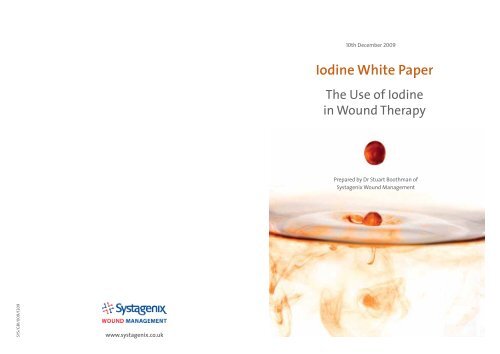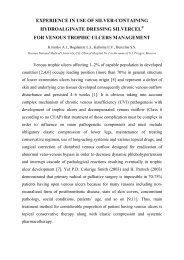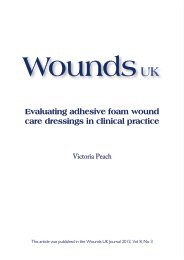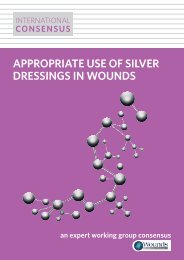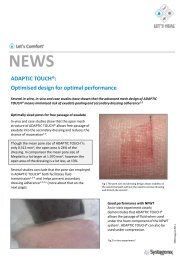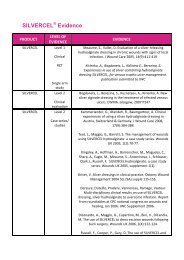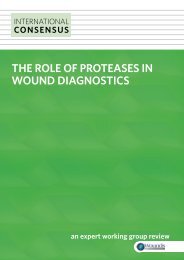Iodine White Paper - Systagenix
Iodine White Paper - Systagenix
Iodine White Paper - Systagenix
- No tags were found...
Create successful ePaper yourself
Turn your PDF publications into a flip-book with our unique Google optimized e-Paper software.
PVP-I solution and occlusion with a patch.Positive results were recorded for 14 patients(2.8%), these 14 patients were then subjectedto a repeated open application test witha PVP-I solution and only 2 of the 14 wererecorded as positive. Therefore it is apparentthat the method used can be an importantdetermining factor when assessing theprevalence of allergic reactions to PVP-I andmay explain the considerable variation inresults reported.iv) Systemic absorptionReports of systemic effects following shorttermPVP-I treatment are extremely rare.Measurement of serum iodide levels of burnspatients indicated that iodine absorptionwas dependent on 2 factors, wound area andduration of treatment (Steen, 1993). Huntet al (1990) also discovered a relationshipbetween wound area and both serum andurine iodine levels following the treatmentof burn wounds with PVP-I, but also proposedthat renal function was a factor. Long-termpovidone iodine use has been associated withmild hyperthyroidism (Nobukuni et al 1997)and long-term use is therefore not advisablefor patients with impaired thyroid function.A number of studies have monitored thyroidfunction during PVP-I clinical trials and havereported it remains unchanged (Zellner andBugyi, 1985; Hunt et al, 1990; Kovacikova et al,2002).Key points• Povidone iodine is the most commonly usediodine treatment used in wound care andmedicine.• Povidone iodine is produced by complexingelemental iodine in a triiodide form withpolyvinylpyrollidone (PVP) Microbicidalactivity is retained, whilst irritation,sensitisation and staining are reduced.• The significant reduction of bioburdenfollowing povidone iodine treatment havebeen demonstrated in an extensive rangeof in-vitro, animal and clinical studies.• The majority of in-vivo and clinical woundstudies indicate that iodine either doesnot delay or only minimally delays woundhealing.• Recent iodine publication reviewsprovide strong evidence that current lowconcentration, slow release PVP-I dressingsare effective and non-toxic.7.3 Cadexomer iodineCadexomer iodine is an iodine complex,first used in 1981 and is now used widely asan antimicrobial agent to treat infected orcritically colonised wounds. In contrast topovidone iodine, there is no chemical bondingbetween the iodine and the carrier agent.Cadexomer iodine is composed of small,spherical, polysaccharide beads containing0.9% iodine. In the presence of exudate, thehydrophilic beads absorb fluid and begin toswell, the pores in the beads enlarge allowingthe slow and sustained release of iodine. Thebeads also have the ability to absorb wounddebris and therefore may provide assistancewith cleansing of the wound. All threeproprietary forms of cadexomer iodine aremade up of the same formulation and areavailable as a powder, dressing or ointment(Thomas and Leigh, 1998). In addition toproviding an antimicrobial effect, somestudies have reported that cadexomer iodineappears to have a stimulatory effect on reepithelialisationof wounds, however themode of action is not clearly understood. Themost common adverse effect associated with9cadeoxmer is a burning or stinging sensationon application, local irritation, redness andeczema (Holloway et al, 1989)7.3.1 Cadexomer iodineantimicrobial efficacy studiesThe efficacy of cadexomer iodine as anantimicrobial agent has been demonstratedin several animal models and clinicalstudies. Mertz (1999) inoculated porcinepartial thickness wounds with methicillinresistantStaphylococcus aureus (MRSA)and investigated the effect of cadexomerdressings. Applied daily, cadexomer iodinesignificantly reduced both MRSA and totalbacteria in the wounds in comparison withthe vehicle (cadexomer without iodine) andthe no treatment control at 1, 2, and 3 daysafter inoculation. The reduction in bacteriaand MRSA was most pronounced after 3 daysof cadexomer iodine treatment, which maysuggest repeat applications enhance theantimicrobial efficacy. A 6-week, multicentre,randomised trial on 93 patients sufferingfrom venous ulcer stasis (mean durationof 2 years) revealed that the application ofcadexomer iodine resulted in significantlyApplied daily,cadexomer iodinesignificantly reducedboth MRSA and totalbacteria in the wounds.reduced infection rates from pathogenicbacteria including Staphylococcus aureusand Pseudomonas aeruginosa (Skog, 1983).A correlation was found between the timetaken to reduce or eliminate infection withStaphylococcus aureus and rate of woundhealing. Danielsen et al (1997) conducted asmall, uncontrolled study on 19 patients withvenous leg ulcers colonised with Pseudomonasaeruginosa. After 1 week of treatment withcadexomer iodine paste, 65% of patientshad negative cultures for Pseudomonasaeruginosa; increasing to 75% after 12 weeks.Microbial colonisation of the wounds wasnot quantified in a number of clinical trials,but the symptoms of infection, such aspain, exudate and oedema were assessed assecondary outcomes. In a randomised trial,Moberg et al (1983) examined the effectof cadexomer on decubitus ulcers in a 34patient study. Cadexomer iodine significantlyreduced levels of pus, debris and pain incomparison with standard treatment. Thesefindings were supported by a publication byHarcup (1986) who recorded that cadexomeriodine initiated a significant reduction inerythema, oedema, exudate, pus, debrisand pain in venous ulcers in comparisonwith control; symptoms all associated withinfection.7.3.2 Cadexomer iodine safetyand wound healing studiesA number of reviews have evaluated theeffect of cadexomer iodine on wound healingand none have concluded that cadexomeriodine delays wound healing (Drosou etal, 2003; Cooper 2007). These findings aresupported by in-vitro study by Zhou et al(2002) in which cadexomer iodine was foundto have no effect on the viability, morphology,
cellular proliferation and the ability toproduce collagen of human fibroblasts.Some studies have in fact recorded thatcadexomer iodine has demonstratedbeneficial effects on wound healing. Inanimal models, cadexomer iodine has beenreported to significantly increase epithelialcell proliferation and epithelialisation innon-infected full-thickness porcine woundsduring the first 9 days of treatment (Lamme,1998). Mertz (1994) also discovered thatepithelialisation of partial thickness woundswas significantly stimulated by cadexomeriodine in comparison with the ointmentcontrol.In some clinical trials an enhanced healingeffect has also been identified followingcadexomer iodine treatment. A 12-week,randomised, controlled, multicentre trial wasconducted by Hansson et al (1998) on 153patients with venous leg ulcers, comparingcadexomer iodine paste with a hydrocolloiddressing and gauze. The mean reduction inulcer size was 62% for the cadexomer pasteiodine versus 41% and 24% for hydrocolloidand paraffin gauze groups respectively.Cadexomer iodine was also found to be morecost effective than the other treatmentsassessed. In another venous leg ulcer study(Holloway et al (1989), patients improvedmore than twice as rapidly using cadexomeriodine (38 patients) in comparison withstandard therapy (37 patients) (p=0.0025).Other beneficial trends to emerge were lowerlevels of pain and exudate and also reducedslough and debris indicating cadexomeriodine may also encourage autolyticdebridement. An 8-week randomisedclinical trial provided further evidence ofthe therapeutic effect of cadexomer iodine(Moberg et al 1983). Decubitus ulcer area wasChronic woundsprovide an idealenvironment to supporta biofilm as it is warm,moist, rich in nutrientsreduced by 76% and complete healing wasachieved in 6 out of 16 patients (37.5%) in thecadexomer iodine group compared with 57%wound area reduction and 1 of 18 patientshealed in the control group. Improved ratesof ulcer healing versus existing standardtherapy was also noted in clinical trials bySkog et al (1983) and also in comparison withother antiseptic agents (Harcup et al, 1986;Laundanska et al, 1988; Ormiston et al, 1985).Not all clinical trials have identified improvedhealing rates following treatment withiodine; Apelqvist et al (1996) examined theeffects of cadexomer iodine on diabetic footulcers and found no significant difference inhealing rates in comparison with gentamicinsolution, streptodornase/streptokinase, ordry saline gauze. It is notable that diabeticfoot ulcer patients did not appear to respondto cadexomer iodine, in contrast with thevenous ulcer studies described above.However a significant amount of furtherresearch would be required to determine ifwound aetiology is a factor in the success ofcadexomer iodine therapy.Floyer and Wilkinson (1988) conducted astudy to evaluate the safety of cadexomeriodine and risk of patient sensitivity. In thefirst phase of the study, patch testing wasperformed on 30 patients with static ordeteriorating venous leg ulcers, no cases ofsensitivity were identified. During the nextphase, 30 patients treated with cadexomeriodine were determined over a 12-weekperiod. All of the 19 patients who completedthe trial, displayed reductions in erythema,exudate, pus and slough and 15 ulcers hadhealed or improved. Again there were nocases of cadexomer iodine sensitivity orallergic reactions identified during thisphase of the trial. Fourteen patients out of 19reported that pain was reduced, although astinging reaction was noted by a few patients.Moore et al (1997) described a mechanismby which cadexomer iodine may aidwound healing beyond its antimicrobialactivity. The release of cytokines by humanmacrophages was stimulated when coculturedin-vitro with cadexomer iodine.It was proposed that cadexomer iodineprovides a pro-inflammatory stimulus in thewound tissue by activation of the residentmacrophages, resulting in the productionof pro-inflammatory cytokines. This in turnwould generate an influx of monocytes andT-lymphocytes into the wound that maytrigger the healing process.Key points• Cadexomer iodine is a complex firstdeveloped in 1981 and now used widely inwound care as an antimicrobial treatment.• Cadexomer iodine is composed of small,spherical polysaccharide beads containingiodine, with no chemical bonding involved.Following the absorption of exudate thebeads swell, creating pores which allow theslow and sustained release of iodine.• A number of in-vivo models and clinicaltrials have confirmed that treatmentwith cadexomer iodine is associated withreduced infection rates.• A number of reviews have evaluated theeffect of cadexomer iodine on woundhealing and none have concluded thatcadexomer iodine delays healing.• It has been suggested in some studies thatcadexomer iodine may encourage woundhealing although a mode of action has notbeen proposed.7.4 <strong>Iodine</strong> and biofilmsBiofilms are a structured community ofinteracting microorganisms encapsulatedwithin a self-developed polymericmatrix known as extracellular polymericsubstance (EPS). Bacterial residing withinbiofilms demonstrate enhanced toleranceto antimicrobials compared with theirplanktonic counterparts: this has beenattributed to the protective propertiesof the EPS, reduced growth rates of cellsresiding within the biofilm and the presenceof resistant persister cells (Gilbert et al2007). Chronic wounds provide an idealenvironment to support a biofilm as it iswarm, moist, rich in nutrients and providesa surface for bacteria attachment. Evidenceexists that indicates bacteria are able to formbiofilms within the wound environment(Serralta et al, 2001; Mertz et al, 2003). It isa widely held belief that the presence ofbiofilms in the wound may induce chronicinflammation and delay the healing processand may ultimately result in infection.Akiyama et al (2004) assessed the activityof cadexomer iodine against Staphylococcusaureus biofilms using confocal laser scanningmicroscopy. From their observations10
they deduced that cadexomer iodinepossessed the ability to disrupt the biofilmstructures and subsequently allowed theStaphylococcus aureus cells to be killed. Theeffect of povidone iodine on establishedStaphylococcus epidermis biofilms hasalso been evaluated (Presterl et al, 2007).Biofilms were isolated from catheter-relatedbacteraemia and cardiac implant infectionsand grown on microtitre plates before beingincubated with 3 antiseptics. Povidoneiodine resulted in a 5-fold log reduction inviable cells within 5 minutes, however apropanol/ethanol/chlorhexidine mixture andhydrogen peroxide were more effective andcompletely eradicated the biofilms. Kunisadaet al (1997) demonstrated that within 10minutes of exposure of Pseudomonasaureginosa biofilms to PVP-I solution (0.2%)no viable cells remained. In comparison,exposure to chlorhexidine gluconate andalkyldiaminoethylglycine hydrochloride didnot result in a reduction of viable cell countafter 60 minutes. However, resistance ofPseudomonas aeruginosa to povidone iodinehas been noted in other studies (Stickler andHewett, 1991; Brown et al, 1995).Hill et al (2006) have successfully developeda mixed species (n=6) biofilm model withbacterial strains isolated from chronicwounds. The model design enabled thesynthesis of multiple, identical biofilms tobe grown simultaneously. Analysis of thebiofilm species composition revealed thatPseudomonas aeruginosa and Staphylococcusaureus predominated, while other specieswere either not detected or on the borderlineof detection. A range of wound dressingshave been evaluated in this model againstboth 7-day biofilms (mature) and 3-daybiofilms (young). There was no significantdifference between silver dressings andthe control alginate dressing when testedagainst mature biofilms. In contrast both thepovidone iodine dressing (INADINE*) and thecadexomer iodine dressing (Iodoflex) killedall the bacterial cells within the biofilms.The low pH of Iodoflex broth (even whenbuffered) may contribute to antimicrobialactivity of the dressing, however this wasnot a factor in the activity of Inadine as thepH of the broth was very close to 7 (neutral).When assessed against the more immature3-day biofilms, two silver dressings caused anoticeable reduction in bacterial numbers,but the remaining silver dressings had noeffect. Once again both iodine dressingsdemonstrated a high level of efficacy andcompletely destroyed the biofilms.Key points• Biofilms are a structured community ofinteracting microorganisms encapsulatedwithin a extracellular polymeric substanceand demonstrate enhanced tolerance toantimicrobial therapies compared with theirplanktonic counterparts.• The presence of biofilms in the wound mayinduce chronic inflammation and delay thehealing process and may ultimately result inthe infection.• The efficacy of iodine on biofilms has beendemonstrated in a range of biofilm models.• In a mixed species biofilm model, iodinedressings (INADINE* and Iodoflex)demonstrated the ability to completely destroymature biofilms while silver dressings weresignificantly less effective with performanceequivalent to the alginate control.118. <strong>Iodine</strong> wound dressings<strong>Iodine</strong> wound dressings have been on themarket for a number of years, but despite thisthe number of dressings available remainslimited. The development of iodine productsfor use in wound treatment appears to havebeen constrained by the almost universaladoption of silver dressings as the primarytreatment for infected wounds.8.1 INADINE* (<strong>Systagenix</strong>Wound Management)INADINE* consists of a low adherentknitted viscose fabric impregnated with apolyethylene glycol (PEG) base containing10% povidone iodine; equivalent to 1.0%available iodine. INADINE* is applied directlyto the wound and covered with a secondarydressing. In the presence of wound fluid, thepovidone iodine is readily released from thePEG base. The dressing undergoes a colourchange from orange to white as the povidoneiodine is released into the wound. The PEGbase used in the production of INADINE* iswater-soluble and allows easy removal fromthe wound bed and the peri-wound skin.INADINE* is indicated for the prophylaxisand treatment of infection in minor burns,leg ulcers and superficial skin-loss injuries.The frequency of dressing changes dependsprimarily upon the condition of the wound.If large quantities of exudate are produced,daily changes will probably be required; butif the wound is relatively dry, the intervalbetween changes may be extended.The strong orange colour of the INADINE*PEG ointment has been described as beingadvantageous to the clinician (Adams, 1985)as it provides an indicator of the continuingavailability of the povidone iodine. Asthe iodine ointment is depleted throughantimicrobial action or dissolved by highlevels of exudate, the PEG base changes fromorange to white indicating the dressing shouldbe changed. Adams suggests unnecessarydressing changes may be prevented bychecking the colour of the dressing, thereforeproviding a cost saving in terms of bothdressing costs and nursing time. It was alsonoted that INADINE* formulation is watersoluble,therefore allowing the wounds tobe cleansed very quickly and effectively withsaline or water following dressing removal.This offers an advantage over conventionaltulle gras dressings which tend to leaveparaffin deposits in the wound.The performance of INADINE* has beenevaluated in a range of comparative clinicaltrials and health economic studies. Themanagement of partial skin thickness burnwounds using INADINE* was evaluatedin comparison with a paraffin gauzedressing containing 0.5% chlorhexidine ina prospective 213 patient randomised trial(Han and Maitra, 1989). Patients treated withINADINE* displayed significantly reducedmean healing time (8.75 days) in comparison
with the chlorhexidine gauze (11.69 days) andas a consequence the number of hospitalvisits was also lower. In addition INADINE*also caused less pain and this was reflected ina significant reduction in the requirement foranalgesia. There was no significant differencebetween the two dressings with regard toadherence or wound appearance.A comparative Czech health economics studyestimating the cost of treating a leg ulcerover a four week period using Granuflex,ACTISORB*, INADINE* and a conventionaltreatment defined as the application ofcalcaria solution and camphor ointment andcoverage with a paste bandage (Pospisilová,INADINE* treatmentwas associated with adecrease in mean painrating from 0.9 to 0.1999). INADINE* was identified as the lowestcost treatment (329.62 CZK), followed byACTISORB* (432.38 CZK), and Granuflex(503.48 CZK). The conventional therapy wasidentified as the most expensive treatment(863.28 CZK).In addition to chronic wounds, INADINE* canbe on used on burns and also on surgicaland trauma wounds. Wilson et al (1986)conducted a clinical trial on 100 patientswith minor burn wounds in which INADINE*was assessed in comparison with a standardpetroleum gauze dressing. There was nosignificant difference between the twotreatment groups for time to wound closure.It should be noted that the burns were notinfected and therefore antimicrobial therapymay not be expected to offer an advantageover petroleum gauze. Secondary outcomesincluded ease of removal, for which bothdressings were rated ‘good’, and pain onremoval where no significant differencebetween treatments was identified.Bacteriological swab analysis was performedand streptococcus pyrogenes, non-haemolyticstreptococcus and staphylococcus aureuswere found to be present in the wounds ofa similar percentage of patients. Coliforms,however, were only present in 16% of woundstreated with INADINE* and 28% of the controlgroup. The total bacterial population of thewound, before and after treatment, howeverwas not determined, therefore it is verydifficult to draw any conclusions regardingthe antimicrobial efficacy.The results of two INADINE* case studies wererecently presented at the 2009 CanadianAssociation Wound Care Conference. In acase series conducted by LeMesurier et al(2009), 9 patients with 11 low to moderatelyexuding wounds of mixed aetiology weretreated with INADINE* over a 6 weektreatment period. Four of the wounds weredescribed as non-infected, 6 were colonisedand 1 was locally infected. Upon completionof the study, INADINE* treatment resultedin mean wound area being reduced from11.7cm to 8.9cm (24% decrease); 6 out of 9patients showed significant improvementand the wounds of two patients completelyhealed. Wound pain scores were awardedby patients throughout the study andINADINE* treatment was associated with adecrease in mean pain rating from 0.9 to 0.No wound infections or adverse effects wererecorded during the course of the study. Inthe second case study (Campbell et al 2009),20 patients who had previously sufferedwound pain following the application oftopical antimicrobials including Iodosorbwere treated with INADINE* over a 6 weekperiod, or until complete healing if achievedearlier. Patients had a variety of wound typesincluding diabetic, vascular and surgicalwounds, and labelled contraindications werethe only exclusion criteria for the study.At 6 weeks, 90% of patients reported noproduct associated pain or wound adherence.An improvement in the condition of thewound also achieved in 80% of patients.In addition, a preference for INADINE*was expressed by 18 out of 20 patients incomparison with their previous treatment,with cost and comfort influential to theirchoice. It was also noted in the study thatother commonly used topical antimicrobialproducts such as Acticoat and Iodosorb (10g)were approximately 8 times and 11 timesthe cost of the equivalent sized INADINE*dressing respectively.A single-blind randomised, controlled trialwas carried out to compare treatment withmedicated honey dressings and INADINE*following toenail surgery (Marshall et al2005). The primary outcome was the numberof days to complete re-epithelialisationfollowing surgery. The mean healing timefor the INADINE* treatment group was 25days (SD=8.70) and was significantly faster(p=0.04) than the honey group (33 days;SD=15.71). One participant in the honeygroup developed a post-operative infection,no infections occurred following treatmentwith INADINE*. Post-operative pain was alsoevaluated during the study and no significantdifference was found between the twotreatment groups. No theory was proposedas to why INADINE* treated wounds achievedhealing more rapidly.Wittich (2001) demonstrated the versatilityof INADINE* by using to it prevent infectionat haemocatheter exit sites in a renalunit. Catheter associated infections pose asignificant risk to the patient and it thereforecritical to ensure the access site is wellmaintained and clean. The author reportsthat protection of the vascular access sitehad previously involved cleaning with 10%povidone iodine and redressing with Meporethree times a week. However despite thesemeasures crusty growths regularly occurredover the catheter exit site. To address thisproblem a new protocol was developed inwhich INADINE* was applied around thecatheter to reduce the risk of infection andthen covered with a TIELLE* dressing. Thisdressing combination resulted in a reductionin catheter site infections in the renal unit,reduced dressing changes and improvedpatient comfort in comparison with theprevious dressing treatment regime, inaddition to preventing the formation ofcrusty growths.8.2 Iodosorb (Smith and Nephew)i) PowderIodosorb is a yellow-brown powder composedof a three dimensional network of cadexomermicrospheres or beads, approximately 0.2mm in diameter. The hydrophilic beadscontain 0.9% w/w of elemental iodine, heldwithin the structure of the polymer. The12
eads are supplied in 3 gram sachets andshould be applied across the wound bed ina layer approximately 3 mm deep, and thencovered with a secondary dressing. Followingthe absorption of wound fluid, the beadsswell and pore size of the cadexomer latticeincreases providing a slow and sustainedrelease of iodine (Sundberg and Meller 1997).Iodosorb has a dual antimicrobial action; inaddition to the bactericidal activity of iodine,the beads also have the ability to take upbacterial and cellular debris from the woundbed by capillary action and hold it withinbead structure. This debris is subsequentlywashed away by irrigation of the wound bedduring dressing change. Iodosorb can be usedfor the treatment of chronic exuding woundssuch as leg ulcers, pressure ulcers and diabeticulcers where an infection is suspected orpresent. The frequency of dressing changeis dependent upon the wound and level ofexudate. The loss of the yellow-brown colourof the beads is a clear indication of whendressing change is required.ii) Iodosorb® Ointment (Smith and Nephew)Iodosorb Ointment consists of cadexomeriodine beads incorporated into macrogolointment base. The ointment functions bythe same mode of action as Iodosorb powderand is indicated for the same conditions. It isapplied onto the wound bed through a singleuse, collapsible tube at a recommended depthof 3 mm. The beads used to manufacturethe paste contain a higher concentrationof iodine than Iodosorb powder to enablethe ointment to be produced with an iodineconcentration of 0.9% w/w.iii) Iodoflex® (Smith and Nephew)Iodoflex is a layer of Iodosorb ointment (0.9%iodine w/w) sandwiched between two layersof gauze. The gauze acts as a protective carrierand also simplifies the application process;the first carrier layer is removed and thepaste wafer is placed directly on the wound.The second gauze carrier is then removed anda secondary dressing applied.8.3 Iodozyme® (Archimed)Iodozyme is an occlusive, two component,hydrogel dressing which like other hydrogelsheet products, provides a moist woundhealing environment, fluid absorption andthe promotion of autolytic debridement.However Iodozyme is unique because itincorporates a biochemical system thatgenerates hydrogen peroxide, which convertsthe low levels of iodide present in thehydrogel into iodine. Two separate dressingcomponents must be applied together inorder to initiate this reaction; the first is ahydrogel sheet dressing containing glucose,which is applied to the wound surface. Thesecond component is a smaller gel sheetcontaining the enzyme glucose oxidase.Once the second gel is applied onto the first,the glucose begins to diffuse between thesheets and the glucose oxidase initiates theoxidation of (beta)-D-glucose to hydrogenperoxide and D-gluconic acid. The hydrogenperoxide subsequently oxidises the iodideions dispersed throughout the hydrogel toproduce free iodine, which is delivered tothe wound bed and exerts an antimicrobialeffect. Oxygen is also produced by thisreaction which has been reported to havea beneficial effect on the cellular processesinvolved in wound healing. Any unreactedhydrogen peroxide that reaches the woundsurface is immediately broken down intowater and oxygen. Iodozyme is indicated forthe treatment of moderately, lightly or nonexudingwounds and for the management ofinfected wounds. The dressing requires theapplication of a semi-permeable film or foamto hold the dressing place.8.4 Repithel® (Mundi Pharma)Repithel® (PVP-ILH) is a liposomal hydrogelcontaining 3% povidone-iodine. Liposomesare small spherical shaped vesicles composedof phospholipids which can be used as acarrier mechanism for the delivery of activeingredients. The phospholipid compositioncan allow the liposome to ‘fuse’ with cellmembranes and therefore enhance delivery.In addition to the antimicrobial activity ofPVP-I, The liposome hydrogel matrix alsoprovides a moist wound healing environmentto aid the healing process.8.5 Betadine Solution(Betadine Microbicides)Betadine solution is an aqueous solutionof povidone iodine developed for topicalantisepsis of skin, wounds and mucousmembranes. Betadine products are availablein a number of formats including a 10%PVP-I solution, a 5% pump activated spray,7.5% surgical scrub, and also as Swab Aid®antiseptic pads and rayon tipped swabsticks which are both impregnated with10% povidone iodine. Betadine is sometimesused as a treatment of infected wounds;cotton gauze or swabs are dipped in Betadinesolution prior to being applied to the woundbed or packed into cavity wounds. There arehowever some drawbacks to this approach.Unlike a standard iodine wound dressing,the quantity of iodine applied to the woundis uncontrolled. Cotton gauze and swabsare also prone to fibre shed (Thomas, 1990);these particles can initiate inflammatoryforeign body reactions which can disrupthealing (Adams, 1913; Wood, 1976). In addition,gauze can adhere strongly to the wound bedif allowed to dry (Valey, 1986), potentiallyresulting in very painful dressing changesfor the patient and damage to the delicatewound tissue9. Potential bacterialresistance to iodineBacterial resistance exists in two forms,intrinsic and acquired. Intrinsic resistanceis attributed to a natural property of thebacteria which provides additional protectionagainst antiseptics, such as the spore coatof Clostidium difficile. Acquired resistance isdeveloped when bacterial genetic materialis modified providing greater resilience, thismodification may then be shared with otherbacterial cells.Despite prolonged and extensive use ofiodine in medicine and wound care, iodineresistantmicrobial strains are exceptionallyrare. A considerable number of publicationshave stated that no evidence of iodineDespite prolonged andextensive use of iodinein medicine and woundcare, iodine-resistantmicrobial strains areexceptionally rare.13


